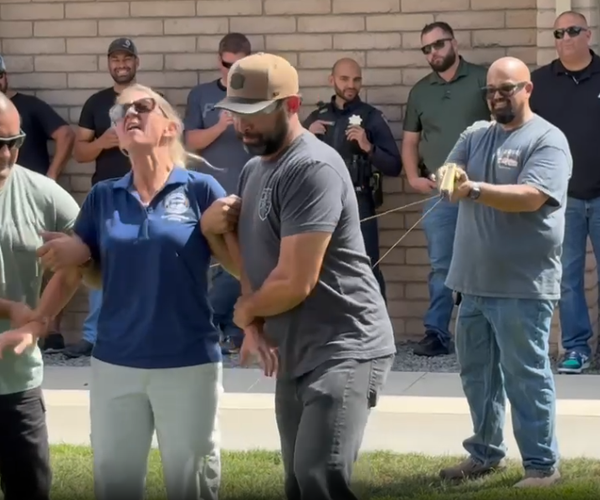The Major League Baseball playoffs are now in full swing.
What better time to recap the ties of one storied baseball team — the New York Yankees — in the chase has with San Joaquin County and Manteca.
New York Yankee great Aaron Judge grew up in Linden, some 20 miles northeast of Manteca.
Judge, who graduated in 2010 from Linden High, was a three-sport athlete for the Lions.
He was a wide receiver for football, a center for basketball, as well as a first baseman and pitcher for baseball.
Judge isn’t the only San Joaquin County connection to the Yankees.
Manteca’s first major league baseball player — Milo Candini — initially played for the New York Yankees farm system in 1936. He never played for the Yankees per se.
And the man who founded the company specializing in age-restricted communities that carries his name — Del Webb — has a 1,407-home neighborhood in Manteca and a 990-home community under construction at River Islands at Lathrop was once a part owner of the Yankees.
Candini was a right-handed pitcher. He played all or part of eight seasons in Major League Baseball for the Washington Senators (1943–44; 1946–49) and Philadelphia Phillies (1950–51).
His Senator pitching career started with five wins, including an 8–0 shutout of the Yankees in The Bronx. In that game, Candini allowed six hits, all singles. He also helped himself at the plate, going two for two with a home run, a double, and two sacrifice bunts
More about Candini
Candini pitched to all-time baseball legend and New York Yankee Lou Gehrig, hit a home run to the deepest reaches of Monument Valley at Yankee Stadium, and guarded President Truman on opening day in 1949.
His major league pitching record was 26 wins, 21 losses; .533 winning percentage; started 37 games; had 13 complete games; pitched a total of 537.2 innings; five shutouts; and won 12 games in relief with eight saves.
Candini had 144 plate appearances with a respectable .243 batting average. As a fielder, he committed a minuscule three errors for a .987 fielding percentage.
Candini graduated from Manteca High in 1935. He played football, basketball and baseball all four years for the Buffaloes.
As a freshman, he played in the outfield on the Manteca High baseball team.
As a sophomore, he pitched sparingly. He was the ace of the pitching staff his junior and senior years.
He once struck out 21 in a single game while playing for the Buffaloes.
After his senior year, Candini signed with the Yankees organization.
Candini ended his pro career in 1958 as a member of the Sacramento Solons after 21 years in organized baseball.
Milo Candini Drive — the street that Manteca’s Big League Dreams sports complex is located on — is named in his honor.
More about Webb
Delbert Eugene Webb was born in Fresno, on May 17, 1899.
By the time Webb learned to read his father was president of local sand and gravel company. It was a family business.
Webb learned carpentry as a hobby when he was a boy and after completing his freshman year in high school, he left school forever. He went to work as a carpenter’s apprentice to help support the family.
His father was a baseball fan and the fascination with the national pastime rubbed off on his son. Throughout the 1920s, young Webb roamed the western United States as a part-time carpenter and semi-pro baseball player.
In 1945, he would become co-owner of the New York Yankees. During the 20 seasons Webb and his partners owned the Yankees, the team won 15 pennants and 10 World Series championships.
In 1928, Webb moved to Phoenix and eventually set up a small construction firm, Del E. Webb, Contractor.
That company would become known for the ability to develop profitable large-scale projects, both commercial and residential. Webb was the primary contractor on Madison Square Garden and the Los Angeles County Museum of Art.
The company won contracts on a number of military housing projects during World War II, refining its ability to create communities “out of nothing,” on previously barren land.
In 1946, Webb built the Flamingo, the first casino/ hotel in Las Vegas, for underworld figure Benjamin “Bugsy” Siegel.
“(Siegel’s) name didn’t mean anything to me at the time,” Webb later confessed. “I sure found out in a hurry.”
The Flamingo signaled the start of big-time gambling in the state of Nevada. It was followed by many other resort properties. In time, Del Webb became the largest gaming operator and private employer in Nevada.
Del Webb Corporation opened its flagship Sun City community in the Phoenix area on Jan. 1, 1960, hosting 100,000 visitors on its first weekend and selling 1,300 homes by the end of that year.
The community’s focus on delivering a highly desirable lifestyle to an age-qualified audience became a company hallmark and created the model for this new market niche in the decades to come. By the time it was built out, Sun City became home to 46,000 residents in 26,000 homes.
To contact Dennis Wyatt, email dwyatt@mantecabulletin.com






